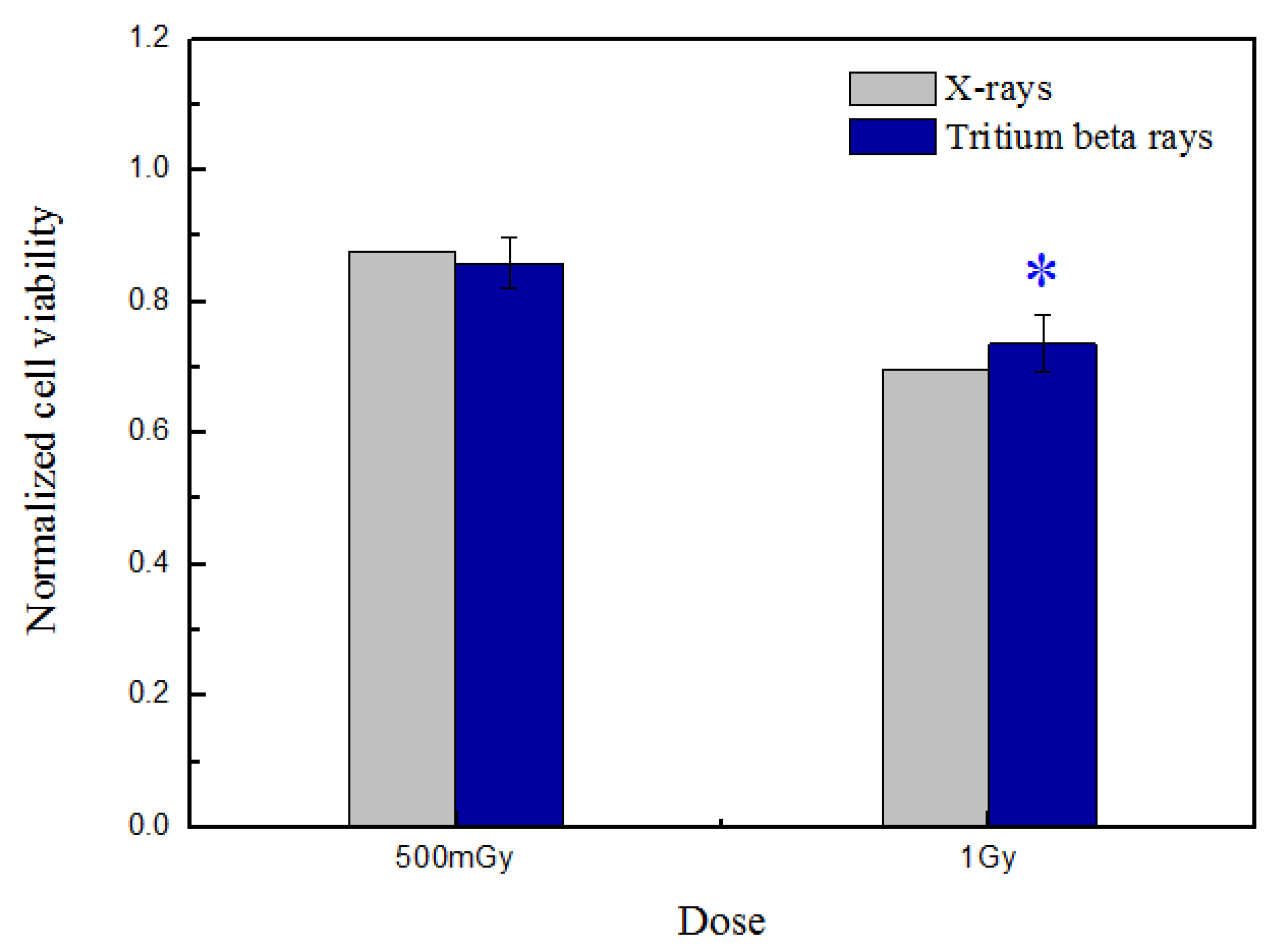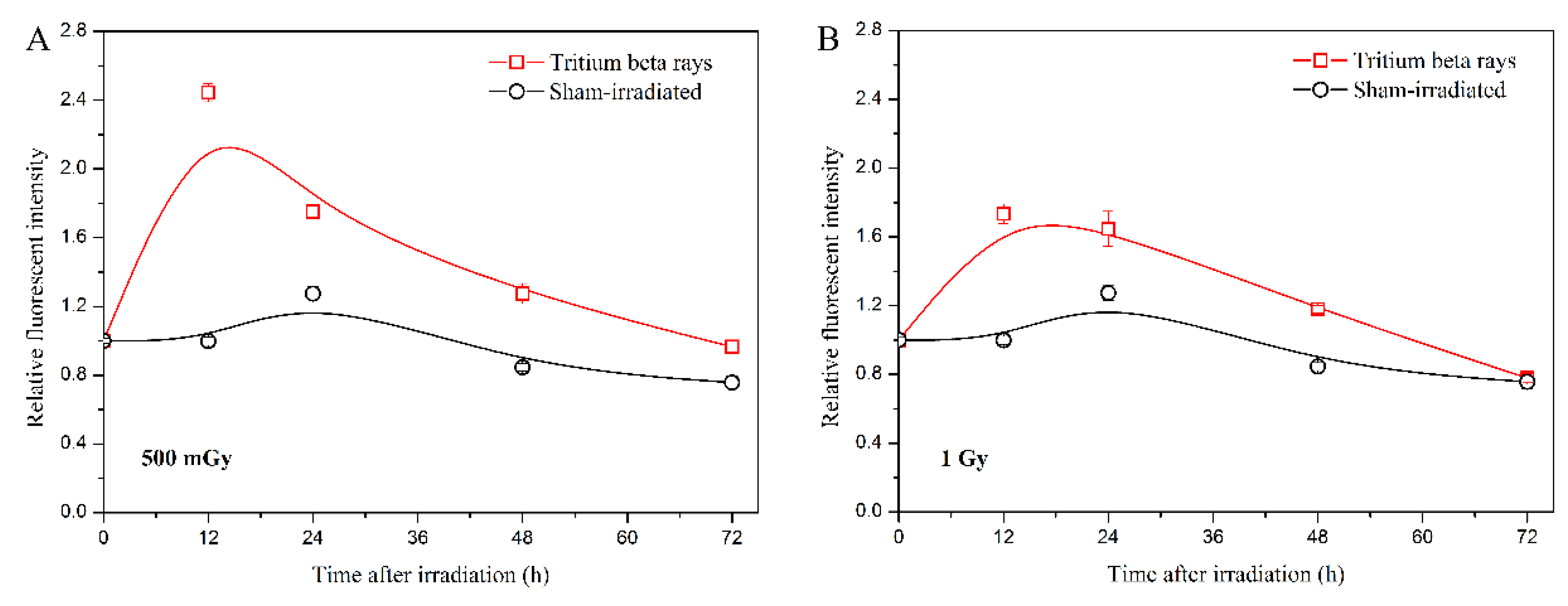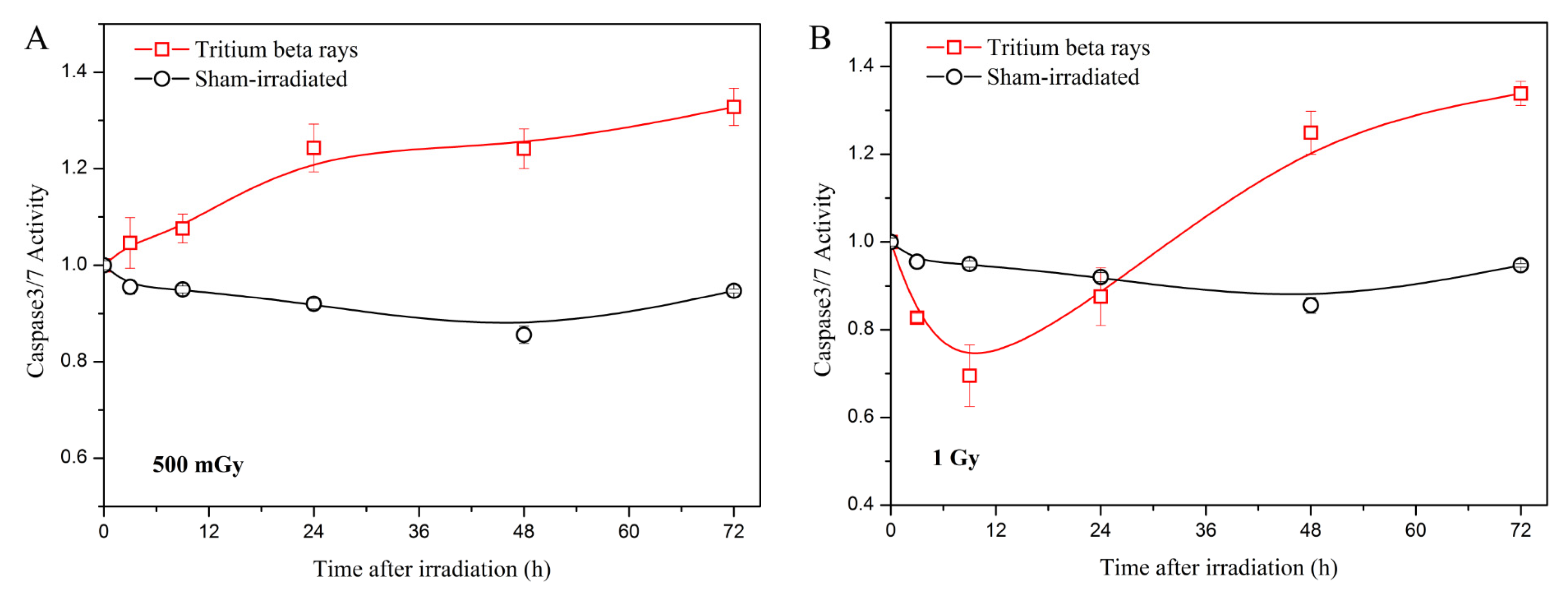Radiation Effects of Normal B-Lymphoblastoid Cells after Exposing Them to Low-Dose-Rate Irradiation from Tritium β-rays
Abstract
:Simple Summary
Abstract
1. Introduction
2. Materials and Methods
2.1. Cell Lines
2.2. Irradiation Protocol
2.3. Cell Viability Assay
2.4. Intracellular ATP Measurements
2.5. Reactive Oxygen Species (ROS) Measurements
2.6. Apoptosis
2.7. Statistical Analysis
2.8. Dose Calculations
3. Results and Discussion
3.1. Analysis of Cell Viability Induced by Tritium β-ray Irradiation
3.2. Mitochondrial Function Related to the Radiation Effects Triggered by the Low-Dose Rate of Tritium β-rays
4. Conclusions
Author Contributions
Funding
Institutional Review Board Statement
Informed Consent Statement
Data Availability Statement
Conflicts of Interest
References
- UNSCEAR. UNSCEAR 2016 Report to the General Assembly, with Scientific Annexes. Sources, Effects and Risks of Ionizing Radiation. Annex C, Biological Effects of Selected Internal Emitters-Tritium; United Nations: New York, NY, USA, 2017. [Google Scholar]
- Guéguen, Y.; Priest, N.D.; Dublineau, I.; Bannister, L.; Benderitter, M.; Durand, C.; Ebrahimian, T.G.; Grégoire, E.; Grison, S.; Ibanez, C.; et al. In vivo animal studies help achieve international consensus on standards and guidelines for health risk estimates for chronic exposure to low levels of tritium in drinking water. Environ. Mol. Mutagen. 2018, 59, 586–594. [Google Scholar] [CrossRef] [PubMed]
- Little, M.P.; Lambert, B.E. Systematic review of experimental studies on the relative biological effectiveness of tritium. Radiat. Environ. Biophys. 2008, 47, 71–93. [Google Scholar] [CrossRef]
- Straume, T.; Carsten, A.L. Tritium radiobiology and relative biological effectiveness. Health Phys. 1993, 65, 657–672. [Google Scholar] [CrossRef] [PubMed]
- Fairlie, I. RBE and w(R) values of Auger emitters and low-range beta emitters with particular reference to tritium. J. Radiol. Prot. 2007, 27, 157–168. [Google Scholar] [CrossRef] [PubMed]
- Potter, C.A. Application of the ICRP clarification of the tritium metabolic model. Health Phys. 2004, 87, 375–381. [Google Scholar] [CrossRef] [PubMed]
- Galeriu, D.; Takeda, H.; Melintescu, A.; Trivedi, A. Energy Metabolism and Human Dosimetry of Tritium. Fusion Sci. Technol. 2005, 48, 795–798. [Google Scholar] [CrossRef]
- Yamamoto, O.; Yokoro, K.; Seyama, T.; Kinomura, A.; Nomura, T. HTO oral administration in mice I: Threshold dose rate for haematopoietic death. Int. J. Radiat. Biol. 1990, 57, 543–549. [Google Scholar] [CrossRef] [PubMed]
- Wang, B.; Zhou, X.Y. Effects of Prenatal Exposure to Low-dose β Radiation from Tritiated Water on the Neurobehavior of Mice. J. Radiat. Res. 1995, 36, 103–111. [Google Scholar] [PubMed]
- Liger, K.; Grisolia, C.; Cristescu, I.; Moreno, C.; Malard, V.; Coombs, D.; Markelj, S. Overview of the TRANSAT (TRANSversal Actions for Tritium) project. Fusion Eng. Des. 2018, 136, 168–172. [Google Scholar] [CrossRef]
- Smirnov, D.G.; Kirillova, E.N.; Muksinova, K.N. The early changes in humoral immunity under the prolonged action of tritium oxide with different dose rates. Radiobiologiia 1990, 30, 129–133. [Google Scholar]
- Satow, Y.; Hori, H.; Lee, J.Y.; Ohtaki, M.; Sawada, S.; Nakamura, N.; Okada, S. Effect of tritiated water on female germ cells: Mouse ocyte killing and RBE. Int. J. Radiat. Biol. 1989, 56, 293–299. [Google Scholar] [CrossRef] [PubMed]
- Balonov, M.I.; Muksinova, K.N.; Mushkacheva, G.S. Tritium radiobiological effects in mammals: Review of the last decade in Russia. Health Phys. 1993, 65, 713–726. [Google Scholar] [CrossRef]
- Chen, J. Radiation quality of tritium. Radiat. Prot. Dosim. 2006, 122, 546–548. [Google Scholar] [CrossRef] [PubMed]
- Alloni, D.; Cutaia, C.; Mariotti, L.U.C.A.; Friedland, W.; Ottolenghi, A. Modeling dose deposition and DNA damage due to low-energy beta emitters. Radiat. Res. 2014, 182, 322–330. [Google Scholar] [CrossRef] [PubMed]
- Tauchi, H.; Imamura, H.; Inoue, M.; Komatsu, K.; Tachibana, A. Assessment of biological effect of tritiated water by using hypersensitive system. Fusion. Sci. Technol. 2011, 60, 1173–1178. [Google Scholar] [CrossRef]
- Umata, T.; Kunugita, N.; Norimura, T. A comparison of the mutagenic and apoptotic effects of tritiated water and acute or chronic caesium-137 gamma exposure on spleen T lymphocytes on normal and p53-deficient mice. Int. J. Radiat. Biol. 2009, 85, 1082–1088. [Google Scholar] [CrossRef] [PubMed]
- Miranda, S.; Correia, M.; Dias, A.G.; Pestana, A.; Soares, P.; Nunes, J.; Lima, J.; Máximo, V.; Boaventura, P. Evaluation of the role of mitochondria in the non-targeted effects of ionizing radiation using cybrid cellular models. Sci. Rep. 2020, 10, 6131. [Google Scholar] [CrossRef]
- Szumiel, I. Ionizing radiation-induced oxidative stress, epigenetic changes and genomic instability: The pivotal role of mitochondria. Int. J. Radiat. Biol. 2015, 91, 1–12. [Google Scholar] [CrossRef] [PubMed]
- Kulkarni, R.; Marples, B.; Balasubramaniam, M.; Thomas, R.A.; Tucker, J.D. Mitochondrial gene expression changes in normal and mitochondrial mutant cells after exposure to ionizing radiation. Radiat. Res. 2010, 173, 635–644. [Google Scholar] [CrossRef]
- Vorob’eva, N.Y.; Kochetkov, O.A.; Pustovalova, M.V.; Grekhova, A.K.; Blokhina, T.M.; Yashkina, E.I.; Osipov, A.A.; Kabanov, D.I.; Surin, P.P.; Barchukov, V.G.; et al. Comparative analysis of the formation of γ2HAX foci in human mesenchymal stem cells exposed to 3H-Thymidine, Tritium oxide, and X-rays irradiation. Bull. Exp. Biol. Med. 2018, 3, 178–181. [Google Scholar] [CrossRef]
- Kelsey-Wall, A.; Seaman, J.C.; Jagoe, C.H.; Dallas, C.E. Biological half-life and oxidative stress effects in mice with low-level, oral exposure to tritium. J. Toxicol. Environ. Health Part A 2006, 69, 201–213. [Google Scholar] [CrossRef] [PubMed]
- Nowosielska, E.M.; Cheda, A.; Zdanowski, R.; Lewicki, S.; Scott, B.R.; Janiak, M.K. Effect of internal contamination with tritiated water on the neoplastic colonies in the lungs, innate anti-tumour reactions, cytokine profile, and haematopoietic system in radioresistant and radiosensitive mice. Radiat. Environ. Bioph. 2018, 57, 251–264. [Google Scholar] [CrossRef] [PubMed]
- McArdle, F.; Pattwell, D.M.; Vasilaki, A.; McArdle, A.; Jackson, M.J. Intracellular generation of reactive oxygen species by contracting skeletal muscle cells. Free. Radic. Biol. Med. 2005, 39, 651–657. [Google Scholar] [CrossRef] [PubMed]
- Islam, M.T. Radiation interactions with biological system. Int. J. Radiat. Biol. 2017, 93, 487–493. [Google Scholar] [CrossRef] [PubMed]
- Gonon, G.; de Toledo, S.M.; Perumal, V.; Jay-Gerin, J.-P.; Azzam, E.I. Impact of the redox environment on propagation of radiation bystander effects: The modulating effect of oxidative metabolism and oxygen partial pressure. Mutat. Res. Toxicol. Environ. Mutagen. 2022, 883–884, 503559. [Google Scholar] [CrossRef] [PubMed]
- Popov, L.D. Mitochondria as intracellular signalling organelles. An update. Cell. Signal. 2023, 109, 110794. [Google Scholar] [CrossRef] [PubMed]
- Handy, D.E.; Loscalzo, J. Redox regulation of mitochondrial function. Antioxid. Redox. Sign. 2012, 16, 1323–1367. [Google Scholar] [CrossRef]
- Bolisetty, S.; Jaimes, E.A. Mitochondria and reactive oxygen species: Physiology and pathophysiology. Int. J. Mol. Sci. 2013, 14, 6306–6344. [Google Scholar] [CrossRef]
- Snyder, A.R.; Morgan, W.F. Persistent oxidative stress and gene expression changes in radiation-induced genomic instability. Int. Congr. Ser. 2003, 1258, 199–206. [Google Scholar] [CrossRef]
- Kim, G.J.; Chandrasekaran, K.; Morgan, W.F. Mitochondrial dysfunction, persistently elevated levels of reactive oxygen species and radiation-induced genomic instability: A review. Mutagenesis 2006, 2, 361–367. [Google Scholar] [CrossRef]
- Kilbride, S.M.; Prehn, J.H.M. Central roles of apoptotic proteins in mitochondrial function. Oncogene 2013, 32, 2703–2711. [Google Scholar] [CrossRef]
- Cao, X.; Wen, P.; Fu, Y.; Gao, Y.; Qi, X.; Chen, B.; Tao, Y.; Wu, L.; Xu, A.; Lu, H.; et al. Radiation induces apoptosis primarily through the intrinsic pathway in mammalian cells. Cell. Signal. 2019, 62, 109337. [Google Scholar] [CrossRef]
- Held, K.D. Radiation-induced apoptosis and its relationship to loss of clonogenic survival. Apoptosis 1997, 2, 265–282. [Google Scholar] [CrossRef]
- Rühm, W.; Woloschak, G.E.; Shore, R.E. Dose and dose-rate effects of ionizing radiation: A discussion in the light of radiological protection. Radiat. Environ. Biophys. 2015, 54, 379–401. [Google Scholar] [CrossRef]
- Alexandrou, A.T.; Li, J.J. Cell Cycle Regulators Guide Mitochondrial Activity in Radiation-Induced Adaptive Response. Antioxid. Redox Signal. 2013, 20, 1463–1480. [Google Scholar] [CrossRef]
- Ojima, M.; Furutani, A.; Ban, N.; Kai, M. Persistence of DNA double strand breaks in normal human cells induced by radiation-induced bystander effect. Radiat. Res. 2011, 175, 90–96. [Google Scholar] [CrossRef]
- Grudzenski, S.; Raths, A.; Conrad, S.; Rübe, C.E.; Löbrich, M. Inducible response required for repair of low dose radiation damage in human fibroblasts. Proc. Natl. Acad. Sci. USA 2010, 107, 14205–14210. [Google Scholar] [CrossRef]
- Fujiwara, M.; Sato, N.; Okamoto, K. Hypoxanthine Reduces Radiation Damage in Vascular Endothelial Cells and Mouse Skin by Enhancing ATP Production via the Salvage Pathway. Radiat. Res. 2022, 197, 583–593. [Google Scholar] [CrossRef]





Disclaimer/Publisher’s Note: The statements, opinions and data contained in all publications are solely those of the individual author(s) and contributor(s) and not of MDPI and/or the editor(s). MDPI and/or the editor(s) disclaim responsibility for any injury to people or property resulting from any ideas, methods, instructions or products referred to in the content. |
© 2024 by the authors. Licensee MDPI, Basel, Switzerland. This article is an open access article distributed under the terms and conditions of the Creative Commons Attribution (CC BY) license (https://creativecommons.org/licenses/by/4.0/).
Share and Cite
Deng, B.; Quan, Y.; Chen, Z.; Wang, H. Radiation Effects of Normal B-Lymphoblastoid Cells after Exposing Them to Low-Dose-Rate Irradiation from Tritium β-rays. Biology 2024, 13, 418. https://doi.org/10.3390/biology13060418
Deng B, Quan Y, Chen Z, Wang H. Radiation Effects of Normal B-Lymphoblastoid Cells after Exposing Them to Low-Dose-Rate Irradiation from Tritium β-rays. Biology. 2024; 13(6):418. https://doi.org/10.3390/biology13060418
Chicago/Turabian StyleDeng, Bing, Yi Quan, Zhilin Chen, and Heyi Wang. 2024. "Radiation Effects of Normal B-Lymphoblastoid Cells after Exposing Them to Low-Dose-Rate Irradiation from Tritium β-rays" Biology 13, no. 6: 418. https://doi.org/10.3390/biology13060418



